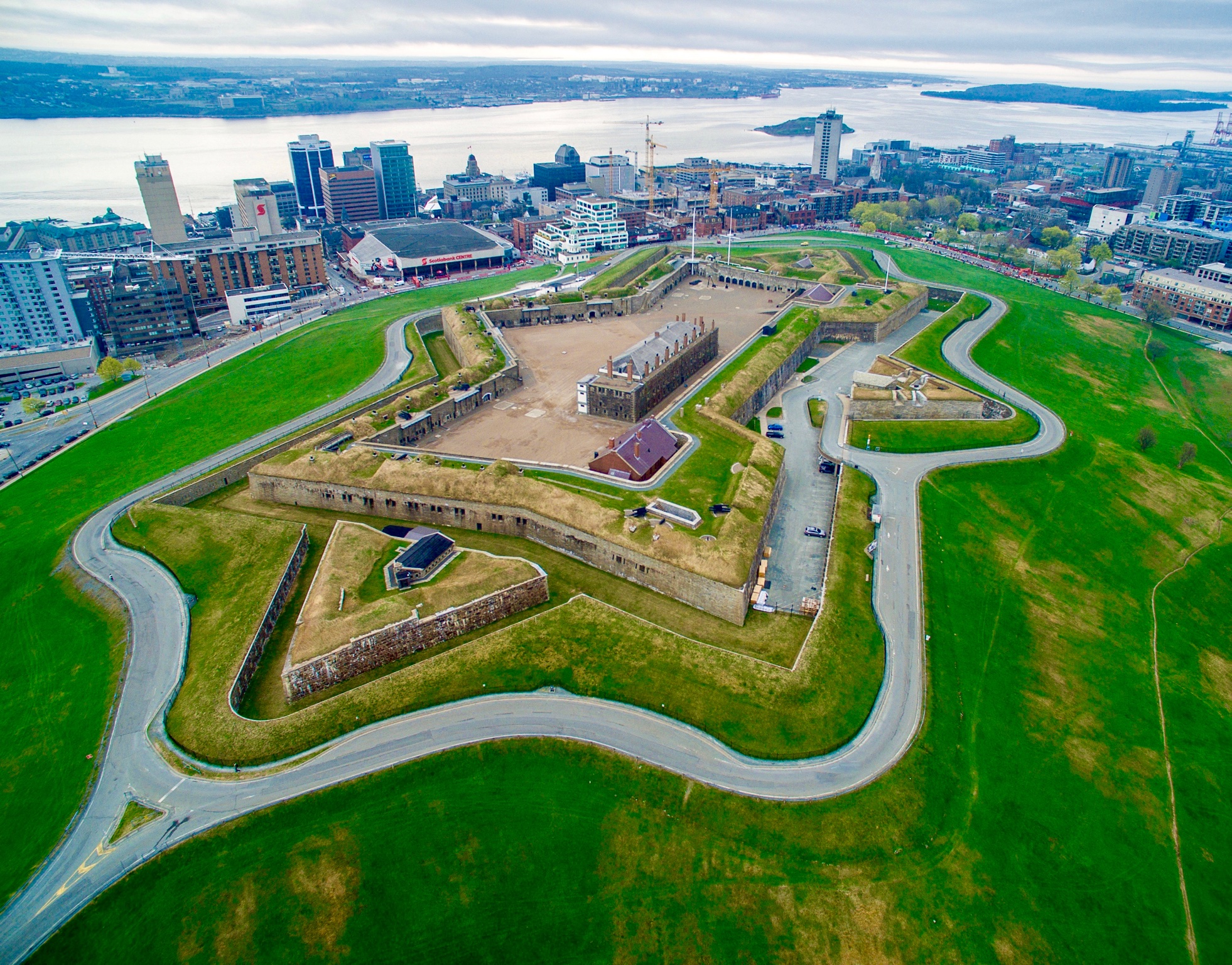Perched on a hilltop overlooking Halifax Harbour is the Citadel National Historic Site. Also known as Fort George, there have been four foritifications built on Citadel Hill since the city was founded by the English in 1749. The third fort (built between 1794 and 1800) was officially named Fort George. According to General Orders of October 20, 1798, it was named after King George III. The first two and the fourth and current fort, were officially called the Halifax Citadel. The last is a concrete star fort and that is the subject of these photos. Over the years, construction and leveling have lowered the summit by ten to twelve meters. Throughout its entire history, the Citadel was never attacked. The following information was culled from Wikipedia.
First Citadel (1749-1776)
The hill was first fortified in 1749, the year Edward Cornwallis oversaw the development of Halifax. The English founded Halifax in 1749 to establish a presence in Nova Scotia as a counterbalance to the French stronghold of Louisbourg, which the Treaty of Aix-la-Chapelle (1748) had returned to France. Halifax was a strategic centre during the next decade in the continuing Anglo-French rivalry in the region. The English recruited Protestant settlers from England, the Palatine, and Switzerland, and constructed fortifications to protect them against raids by the French, colonial Acadians, and allies from the Wabanaki Confederacy (primarily the Mi’kmaq). The first fort was a small redoubt, with a flagstaff and guardhouse near the summit just east of the south ravelin of the present citadel.
Second Citadel (1776-1795)
This was the first permanent fort built on Citadel Hill. Built in 1776, the new fort on Citadel Hill was composed of multiple lines of overlapping earthen redans backing a large outer palisade wall. At the center was a three-story octagonal blockhouse mounting a fourteen-gun battery and accommodating 100 troops. The entire fortress mounted 72 guns and they afforded the Royal Navy the most secure and strategic base in North America. The massive British military presence in Halifax focused through Citadel Hill and the Royal Navy’s dockyard is thought to be one of the main reasons that Nova Scotia—the fourteenth British colony—remained loyal to the Crown throughout and after the American Revolutionary War. By 1784 the fortification was in ruins except for the blockhouse
Third Citadel (1796-1828)
The French Revolutionary Wars that began in 1793 raised a new threat to Halifax. A new citadel was designed in 1794 and completed by 1800. The top of the hill was leveled and lowered a further 15 feet to accommodate a larger fortress on the summit. It resembled the outline of the final Citadel, comprising four bastions surrounding a central barracks and magazine, but used mainly earthwork walls. The Third Citadel received hasty repairs and a new magazine during the War of 1812 in case of an American raid, but the British did not construct new fortifications. The significant British Royal Navy presence in this area made an American siege unlikely. By 1825 all the works except the powder magazine were in ruins, and a new citadel was being designed.
Fourth Citadel (1828-present)
Construction of the current Citadel began in 1828. However, the star-shaped fortress was not completed until in 1856, during the Victorian Era, for a total of 28 years of construction. This massive masonry-construction fort was designed to repel both a land-based attack or attack from the water by United States forces and was inspired by the designs of Louis XIV’s commissary of fortifications Sébastien Le Prestre, Seigneur de Vauban. The Halifax Citadel was constructed to defend against smoothbore weaponry; it became obsolete following the introduction of more powerful rifled guns in the 1860s. British forces upgraded Fort George’s armaments to permit it to defend the harbour as well as land approaches, using heavier and more accurate long-range artillery. The Citadel’s two large ammunition magazines also served as the central explosive store for Halifax defences, making Citadel Hill, according to the historian and novelist Thomas Head Raddall, “like Vesuvius over Pompeii, a smiling monster with havoc in its belly”. Citadel Hill’s various fortifications were garrisoned by the British Army until 1906, and afterward by the Canadian Army throughout the First World War.
Fort George’s final military role was to provide temporary barracks, signaling, and the central coordinating point for the city’s anti-aircraft defences during the Second World War.
The interior photos were taken in the soldier’s barracks. Eleven servicemen occupied each unit and they lived in a very tight space. You will notice the fold up beds as well as the stove and dining table. In some cases, servicemen also lived with their wives and children, further cramping the barracks.
#halifax #novascotia #citadel #halifaxcitadel

